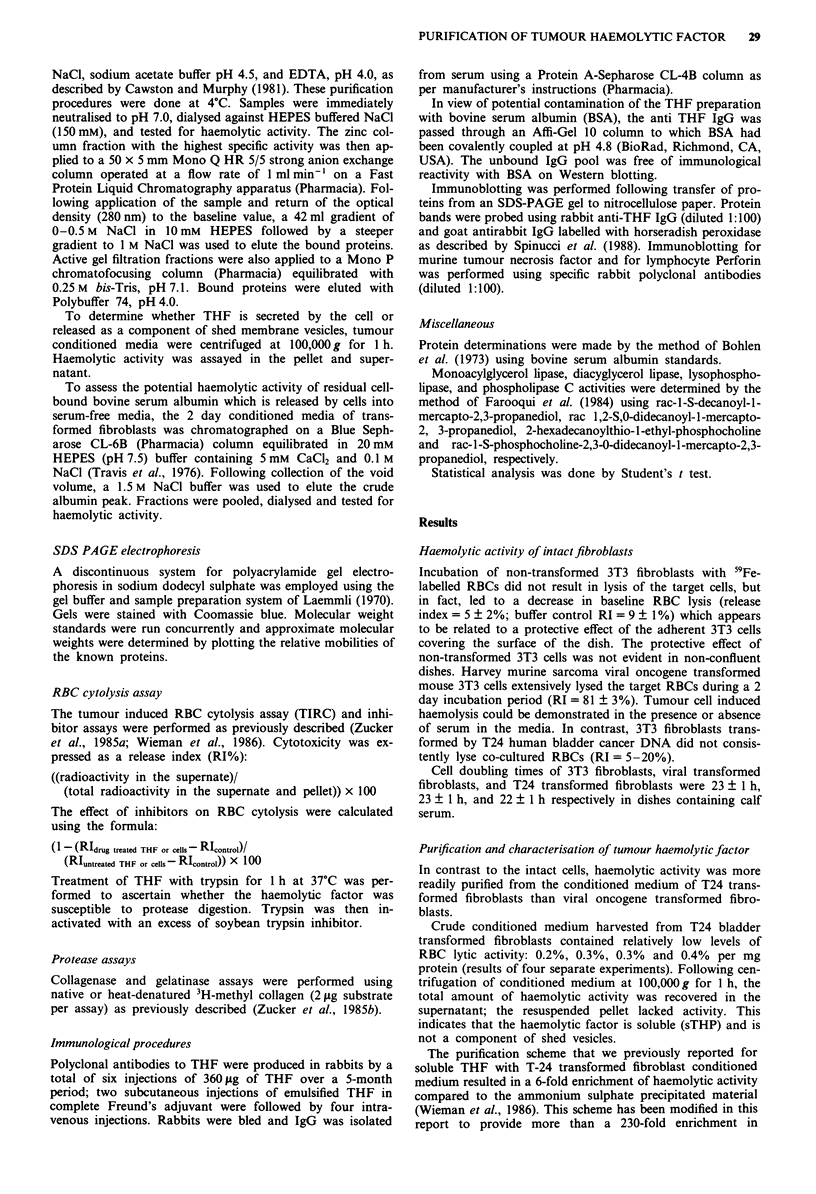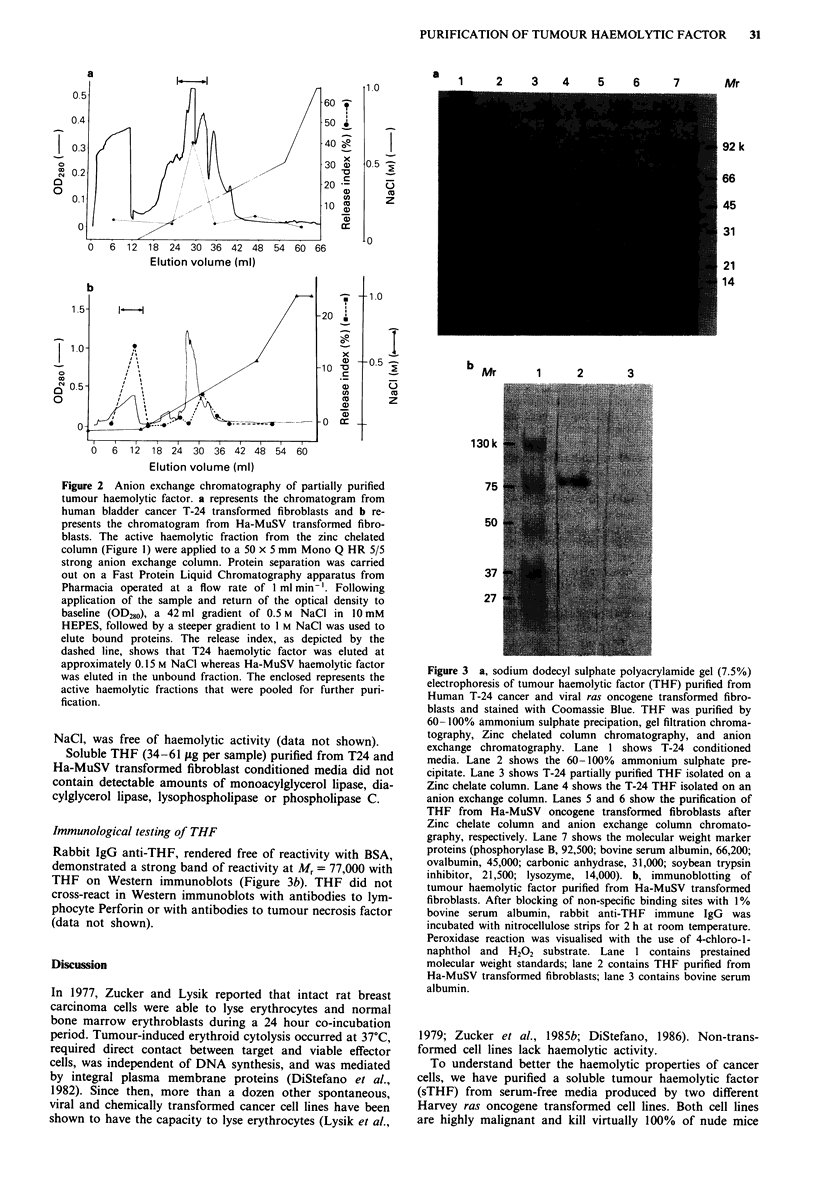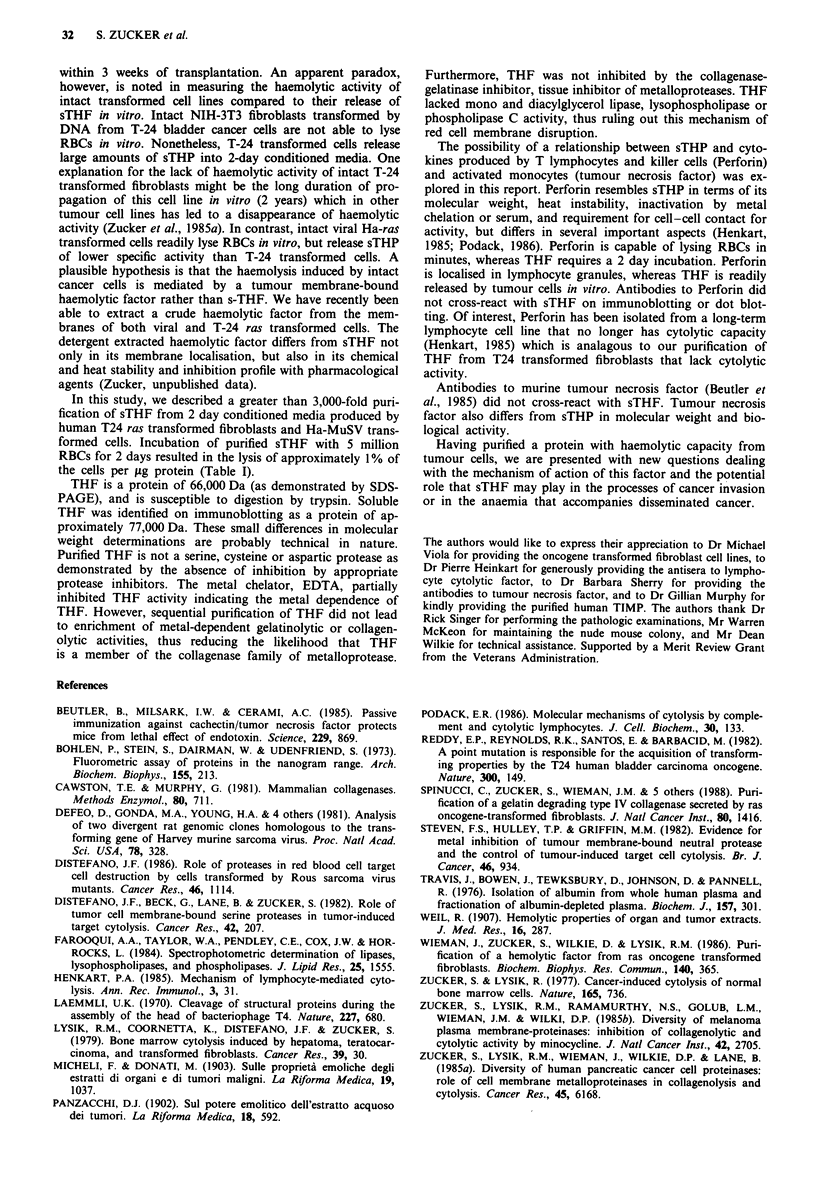Abstract
Numerous studies have shown that intact cancer cells and cell extracts have the capacity to lyse erythrocytes in vitro. The transformation of NIH-3T3 fibroblasts by ras oncogenes has recently been demonstrated to result in tumour cells releasing a haemolytic factor. The purpose of this study has been to purify and further characterise the soluble tumour haemolytic factor (sTHF) produced by mouse fibroblasts transformed by T24 human bladder cancer DNA and by the cloned Harvey murine sarcoma viral oncogene. To this end, transformed fibroblasts were cultivated in serum-free medium. The cell-free supernatant was treated with ammonium sulphate and the precipitate achieved at 60-100% saturation was dialysed and applied to a gel filtration column. A haemolytic factor was eluted with an Mr between 65,000 and 75,000. Zinc chelate and strong anion exchange column chromatography resulted in greater than 3,000-fold enrichment of sTHF. SDS-PAGE of sTHF resulted in a single protein band of 66,000 Da. Soluble THF had no immunological cross-reactivity with known cytokines produced by lymphocytes and macrophages. The pathophysiological role of sTHF in cancer remains to be determined.
Full text
PDF




Images in this article
Selected References
These references are in PubMed. This may not be the complete list of references from this article.
- Beutler B., Milsark I. W., Cerami A. C. Passive immunization against cachectin/tumor necrosis factor protects mice from lethal effect of endotoxin. Science. 1985 Aug 30;229(4716):869–871. doi: 10.1126/science.3895437. [DOI] [PubMed] [Google Scholar]
- Böhlen P., Stein S., Dairman W., Udenfriend S. Fluorometric assay of proteins in the nanogram range. Arch Biochem Biophys. 1973 Mar;155(1):213–220. doi: 10.1016/s0003-9861(73)80023-2. [DOI] [PubMed] [Google Scholar]
- Cawston T. E., Murphy G. Mammalian collagenases. Methods Enzymol. 1981;80(Pt 100):711–722. doi: 10.1016/s0076-6879(81)80054-7. [DOI] [PubMed] [Google Scholar]
- DiStefano J. F., Beck G., Lane B., Zucker S. Role of tumor cell membrane-bound serine proteases in tumor-induced target cytolysis. Cancer Res. 1982 Jan;42(1):207–218. [PubMed] [Google Scholar]
- DiStefano J. F. Role of proteases in red blood cell target cell destruction by cells transformed by Rous sarcoma virus mutants. Cancer Res. 1986 Mar;46(3):1114–1119. [PubMed] [Google Scholar]
- Farooqui A. A., Taylor W. A., Pendley C. E., 2nd, Cox J. W., Horrocks L. A. Spectrophotometric determination of lipases, lysophospholipases, and phospholipases. J Lipid Res. 1984 Dec 15;25(13):1555–1562. [PubMed] [Google Scholar]
- Henkart P. A. Mechanism of lymphocyte-mediated cytotoxicity. Annu Rev Immunol. 1985;3:31–58. doi: 10.1146/annurev.iy.03.040185.000335. [DOI] [PubMed] [Google Scholar]
- Laemmli U. K. Cleavage of structural proteins during the assembly of the head of bacteriophage T4. Nature. 1970 Aug 15;227(5259):680–685. doi: 10.1038/227680a0. [DOI] [PubMed] [Google Scholar]
- Lysik R. M., Cornetta K., DiStefano J. F., Zucker S. Bone marrow cytolysis induced by hepatoma, teratocarcinoma, and transformed fibroblasts. Cancer Res. 1979 Jan;39(1):30–34. [PubMed] [Google Scholar]
- Podack E. R. Molecular mechanisms of cytolysis by complement and by cytolytic lymphocytes. J Cell Biochem. 1986;30(2):133–170. doi: 10.1002/jcb.240300205. [DOI] [PubMed] [Google Scholar]
- Reddy E. P., Reynolds R. K., Santos E., Barbacid M. A point mutation is responsible for the acquisition of transforming properties by the T24 human bladder carcinoma oncogene. Nature. 1982 Nov 11;300(5888):149–152. doi: 10.1038/300149a0. [DOI] [PubMed] [Google Scholar]
- Spinucci C., Zucker S., Wieman J. M., Lysik R. M., Imhof B., Ramamurthy N., Liotta L. A., Nagase H. Purification of a gelatin-degrading type IV collagenase secreted by ras oncogene-transformed fibroblasts. J Natl Cancer Inst. 1988 Nov 2;80(17):1416–1420. doi: 10.1093/jnci/80.17.1416. [DOI] [PubMed] [Google Scholar]
- Steven F. S., Hulley T. P., Griffin M. M., Itzhaki S. Evidence for metal inhibition of tumour membrane-bound neutral protease and the control of tumour-induced target cell cytolysis. Br J Cancer. 1982 Dec;46(6):934–939. doi: 10.1038/bjc.1982.304. [DOI] [PMC free article] [PubMed] [Google Scholar]
- Travis J., Bowen J., Tewksbury D., Johnson D., Pannell R. Isolation of albumin from whole human plasma and fractionation of albumin-depleted plasma. Biochem J. 1976 Aug 1;157(2):301–306. doi: 10.1042/bj1570301. [DOI] [PMC free article] [PubMed] [Google Scholar]
- Wieman J., Zucker S., Wilkie D., Lysik R. M. Purification of a hemolytic factor from ras oncogene transformed fibroblasts. Biochem Biophys Res Commun. 1986 Oct 15;140(1):365–371. doi: 10.1016/0006-291x(86)91099-5. [DOI] [PubMed] [Google Scholar]
- Zucker S., Lysik R. M., Wieman J., Wilkie D. P., Lane B. Diversity of human pancreatic cancer cell proteinases: role of cell membrane metalloproteinases in collagenolysis and cytolysis. Cancer Res. 1985 Dec;45(12 Pt 1):6168–6178. [PubMed] [Google Scholar]
- Zucker S., Lysik R. Cancer-induced cytolysis of normal bone marrow cells. Nature. 1977 Feb 24;265(5596):736–737. doi: 10.1038/265736a0. [DOI] [PubMed] [Google Scholar]



